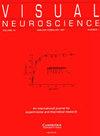弱视的早期诊断。
IF 2.3
4区 医学
Q4 NEUROSCIENCES
引用次数: 19
摘要
弱视在早期治疗时更容易改善或消除。由于大龄儿童的弱视通常对治疗反应较差(Holmes et al., 2011),因此早期识别弱视及其危险因素并进行后续治疗是有价值的。临床倾向于在7岁之前的儿童中进行治疗,因为7岁之前的儿童通常更容易获得最佳的视力结果。本文章由计算机程序翻译,如有差异,请以英文原文为准。
Early diagnosis of amblyopia.
Amblyopia can be improved or eliminated more easily when treated early in life. Because amblyopia in older children is generally less responsive to treatment (Holmes et al., 2011), there is a premium on the early identification of amblyopia and its risk factors and the subsequent treatment thereof. Clinical preference is to institute treatment in children before 7 years of age when an optimal visual outcome is typically easier to obtain.
求助全文
通过发布文献求助,成功后即可免费获取论文全文。
去求助
来源期刊

Visual Neuroscience
医学-神经科学
CiteScore
2.20
自引率
5.30%
发文量
8
审稿时长
>12 weeks
期刊介绍:
Visual Neuroscience is an international journal devoted to the publication of experimental and theoretical research on biological mechanisms of vision. A major goal of publication is to bring together in one journal a broad range of studies that reflect the diversity and originality of all aspects of neuroscience research relating to the visual system. Contributions may address molecular, cellular or systems-level processes in either vertebrate or invertebrate species. The journal publishes work based on a wide range of technical approaches, including molecular genetics, anatomy, physiology, psychophysics and imaging, and utilizing comparative, developmental, theoretical or computational approaches to understand the biology of vision and visuo-motor control. The journal also publishes research seeking to understand disorders of the visual system and strategies for restoring vision. Studies based exclusively on clinical, psychophysiological or behavioral data are welcomed, provided that they address questions concerning neural mechanisms of vision or provide insight into visual dysfunction.
 求助内容:
求助内容: 应助结果提醒方式:
应助结果提醒方式:


